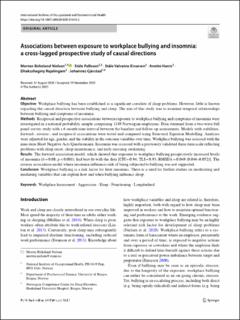| dc.description.abstract | Objective Workplace bullying has been established as a significant correlate of sleep problems. However, little is known regarding the causal direction between bullying and sleep. The aim of this study was to examine temporal relationships between bullying and symptoms of insomnia. Methods Reciprocal and prospective associations between exposure to workplace bullying and symptoms of insomnia were investigated in a national probability sample comprising 1149 Norwegian employees. Data stemmed from a two-wave full panel survey study with a 6-month time interval between the baseline and follow-up assessments. Models with stabilities, forward-, reverse-, and reciprocal associations were tested and compared using Structural Equation Modelling. Analyses were adjusted for age, gender, and the stability in the outcome variables over time. Workplace bullying was assessed with the nine-item Short Negative Acts Questionnaire. Insomnia was assessed with a previously validated three item scale reflecting problems with sleep onset, sleep maintenance, and early morning awakening. Results The forward association model, which showed that exposure to workplace bullying prospectively increased levels of insomnia (b = 0.08; p < 0.001), had best fit with the data [CFI = 0.94; TLI = 0.93; RMSEA = 0.049 (0.046–0.052)]. The reverse association model where insomnia influences risk of being subjected to bullying was not supported. Conclusion Workplace bullying is a risk factor for later insomnia. There is a need for further studies on moderating and mediating variables that can explain how and when bullying influence sleep. | |
